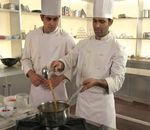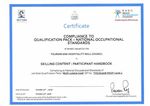Participant Handbook - Multi-Cuisine Cook - NSDC
←
→
Page content transcription
If your browser does not render page correctly, please read the page content below
Participant Handbook
Sector
TOURISM AND HOSPITALITY
Sub-Sector
RESTAURANT
Occupation
Roadside Eateries
Reference ID: THC/Q3006, Version 1.0
NSQF Level 4
Multi-Cuisine CookPublished by All Rights Reserved, First Edition, October 2016 Printed in India at Copyright © 2016 Address: 801, 8th Floor, Tower A Unitech Signature Tower South City 1, Gurgaon-122001 Haryana, India Email: info@thsc.in Web: www.thsc.in Phone number: +91 (0) 124 4160511/12 ISBN Disclaimer The information contained herein has been obtained from sources reliable to Tourism and Hospitality Skill Council. Tourism and Hospitality Skill Council disclaims all warranties to the accuracy, completeness or adequacy of such information. Tourism and Hospitality Skill Council shall have no liability for errors, omissions, or inadequacies, in the information contained herein, or for interpretations thereof. Every effort has been made to trace the owners of the copyright material included in the book. The publishers would be grateful for any omissions brought to their notice for acknowledgements in future editions of the book. No entity in Tourism and Hospitality Skill Council shall be responsible for any loss whatsoever, sustained by any person who relies on this material. The material in this publication is copyrighted. No parts of this publication may be reproduced, stored or distributed in any form or by any means either on paper or electronic media, unless authorised by the Tourism and Hospitality Skill Council.
Acknowledgements
Tourism and Hospitality Skill Council and ILFS would like to express their gratitude to all
the individuals and organizations who have contributed in the preparation of this trainee
manual.
We would like to thank Mr Arun Nanda, Chairman of Tourism and Hospitality Skill Council
for his constant guidance and support. We would also like to acknowledge the efforts
put in by the THSC team, our Governing Body members along with our Industry Partners
who collaborated in the preparation of the different modules. Sincere appreciation is also
extended to all who provided subject matter inputs and review for the individual modules.
The preparation of this manual would not have been possible without the support of the
Tourism and Hospitality Industry. The Industry feedback has been extremely encouraging
from inception to conclusion & it is with their inputs that we have tried to bridge the skill
gaps existing today in the Industry.
This participant manual is dedicated to all the aspiring youth who desire to achieve special
skills which would be a lifelong asset for their future endeavors and help them make a
bright career in the Tourism and Hospitality Sector.
October -2016 CEO
THSC
vParticipant Handbook
About this book
The Indian Tourism & Hospitality industry has shown immense growth potential among the services
sector in India. As one of the leading avenues for employment in the country, the role played by this
industry in the economic development of India is pivotal. However despite its vast potential, the
industry faces a key challenge of shortage of skilled and trained manpower.
There is a vast difference between the required skill and available skills of service providers in the
industry today. To reduce the skill gap, appropriate skilling of workforce needs to be carried out .This
will not only empower the service providers but also benefit the Tourism & Hospitality industry in
terms of quality and productivity.
This Participant Handbook is developed to impart training for the skill and knowledge required to
work as a Multi-cuisine Cook in the Tourism & Hospitality industry. It is designed based on Multi-
cuisine Cook Qualification Pack under the National Skill Qualification Framework. It comprises of the
following NOS/ topics.
• Arrange and manage food resources in the kitchen.
• Cook variety of food.
• Communicate with customer and colleagues.
• Maintain customer-centric service orientation.
• Maintain standard of etiquette and hospitable conduct.
• Follow gender and age sensitive service practices.
• Maintain IPR of organisation and customers.
• Maintain health and hygiene.
• Maintain safety at workplace.
• Learn a foreign or local language(s) including English.
This book is designed considering the lower educational background of the hospitality staff. Therefore
special efforts have been made to explain the concept required for the job mostly through photos
and illustrations.
Units and symbols used in the book have been listed below.
Symbols Used
Key Learning Steps Exercise Tips Notes Objectives
Outcomes
viMulti-Cuisine Cook
Table of Contents
S.No. Modules and Units Page No.
1. Introduction 1
Unit 1.1 – Introduction to the Training Programme 3
Unit 1.2 – Introduction to the Tourism and Hospitality Sector 7
Unit 1.3 – Introduction to Culinary History 10
2. Maintain Health and Hygiene (THC/N9906) 17
Unit 2.1 – Personal Hygiene 19
Unit 2.2 – Health and Hygiene Procedures 21
Unit 2.3 – Hygiene Standards and Safety 23
Unit 2.4 – Housekeeping and Waste Disposal 26
3. Maintain Safety at Work (THC/N9907) 31
Unit 3.1 – Workplace Hazards 33
Unit 3.2 – Safety Practices 34
Unit 3.3 – Personal Protective Equipment 37
4. Arranging and Managing Food Resources in the Kitchen (THC/N3005) 41
Unit 4.1 – Food Production Materials and Equipment 43
Unit 4.2 – Resources Used in Kitchen 58
Unit 4.3 – Inventory Control 60
Unit 4.4 – Storing Raw Materials and Cooked Food Materials 63
5. Basic Food and Beverage Production (THC/N3006) 69
Unit 5.1 – Basic Kitchen Operations 71
Unit 5.2 – Quality Control System 138
Unit 5.3 – Menu 142
6. Communicate with Customers and Colleagues (THC/N9901) 147
Unit 6.1 – Introduction to Communication 149
Unit 6.2 – Communicating with the Team 151
Unit 6.3 – Communicating with Guest 152
7. Maintain Customer-Centric Service Orientation (HCS/N9902) 159
Unit 7.1 – Customer Centric Orientation for Quality Assurance 161
viiParticipant Handbook
8. Follow Gender and Age Sensitive Practices (HCS/N9904) 165
Unit 8.1 – Age and Gender Specific Customer Services 167
Unit 8.2 – Safety and Security Services Available 169
9. Maintain Standard of Etiquette and Hospitable Conduct (HCS/N9903) 175
Unit 9.1 – Etiquettes, Manners and Professional Behaviour 177
Unit 9.2 – Branding 178
10. Learn a Foreign or Local Language(s) Including English (THC/N9909) 181
Unit 10.1 – Achieving Language Proficiency 183
11. Maintain IPR of Organisation and Customer (THC/N9905) 187
Unit 11.1 – Intellectual Property Rights (IPR) 189
12. Employability & Entrepreneurship Skills 193
Unit 6.1 – Personal Strengths & Value Systems 197
Unit 6.2 – Digital Literacy: A Recap 216
Unit 6.3 – Money Matters 221
Unit 6.4 – Preparing for Employment & Self Employment 232
Unit 6.5 – Understanding Entrepreneurship 241
Unit 6.6 – Preparing to be an Entrepreneur 268
viiiMulti-Cuisine Cook
1. Introduction
Unit 1.1 - Introduction to the Training Programme
Unit 1.2 - Introduction to the Tourism and Hospitality Sector
Unit 1.3 - Introduction to Culinary History
1Participant Handbook
Key Learning Outcomes
At the end of this unit, you will be able to:
1. Discuss the purpose and benefits of training programme
2. Discuss the National Occupation Standards and Qualification Pack
3. Explain the responsibilities and personal attribute of a Multi-Cuisine Cook
4. Discover historical background of tourism and hospitality sector
5. Examine American inns and English inns & international and domestic hotel chains
6. Discover world culinary history
7. Identify variety of cuisines available across the world
8. List the variety of dishes prepared in the countries
2Multi-Cuisine Cook
UNIT 1.1: Introduction to the Training Programme
Unit Objectives
At the end of this unit, you will be able to:
1. Discuss the purpose and benefits of training programme
2. Discuss the National Occupation Standards and Qualification Pack
3. Explain the responsibilities and personal attribute of a Multi-Cuisine Cook
1.1.1 Purpose and Benefits of the Training Programme
This training programme is developed to impart specific skills to individuals who wish to
perform as a Multi-Cuisine Cook. The training program is based upon National Occupation
Standards for a cooking. The National Occupation Standards have been described in the
following subsection of this chapter.
Fig.1.1.1- Classroom session Fig.1.1.2 - Multi-Cuisine cooks at work
The training programme will enable an individual to:
• arrange and manage food resources in the kitchen;
• cook variety of food;
• communicate with customer and colleagues;
• maintain customer-centric service orientation;
• maintain standard of etiquette and hospitable conduct;
• follow gender and age sensitive service practices;
• maintain IPR of organisation and customers;
• maintain health and hygiene;
• maintain safety at workplace;
• learn a foreign or local language(s) including English.
3Participant Handbook
This training programme is developed to impart specific skills to individuals who wish to perform
as a Multi-Cuisine Cook. The training program is based upon National Occupation Standards for
a cooking. The National Occupation Standards have been described in the following subsection
of this chapter.
Fig.1.1.4 - Classroom session
The training programme will enable an individual to:
• arrange and manage food resources in the kitchen;
• cook variety of food;
• communicate with customer and colleagues;
• maintain customer-centric service orientation;
• maintain standard of etiquette and hospitable conduct;
• follow gender and age sensitive service practices;
• maintain IPR of organisation and customers;
• maintain health and hygiene;
• maintain safety at workplace;
• learn a foreign or local language(s) including English.
After successful completion of training and passing the assessment you will be issued a
certificate. This will get you an employment as a multi-cuisine cook in food production area.
This certificate will help you to get job and earn better wages than an untrained person.
4Multi-Cuisine Cook
1.1.2 Introduction to QP and NOS
This training programme is intended for imparting basic skill and knowledge relevant to cooking
occupation required to perform in a kitchen. This programme is based on qualification pack
called Multi-Cuisine Cook. The Qualification Pack Code for Multi-cuisine Cook is THC/Q3006.
It is also called a QP.
A QP consists of a set of National Occupational Standards (NOS). NOS specifies the standard
competency a worker must achieve when carrying out a function in the workplace.
Under Multi-Cuisine Cook QP there are ten NOSs, which detail the functions to be performed
in a kitchen by a Multi-Cuisine Cook.
NOS Code Major Function/Task
THC/N3005 Arrange and Manage Food Resources in the Kitchen
THC/N3006 Cook Variety of Food
THC/N9901 Communicate with Customer and Colleagues
THC/N9902 Maintain Customer-Centric Service Orientation
THC/N9903 Maintain Standard of Etiquette and Hospitable Conduct
THC/N9904 Follow Gender and Age Sensitive Service Practices
THC/N9905 Maintain IPR of Organisation and Customers
THC/N9906 Maintain Health and Hygiene
THC/N9907 Maintain Safety at Workplace
THC/N9909 Learn a Foreign or Local Language(s) including English
1.1.3 Responsibilities of Multi-Cuisine Cook
In a kitchen, a multi-cuisine cook is expected to perform the following tasks:
• arrange and manage food resources in the kitchen;
• cook variety of food;
• communicate with customer and colleagues;
• maintain customer-centric service orientation;
• maintain standard of etiquette and hospitable conduct;
• follow gender and age sensitive service practices;
• maintain IPR of organisation and customers;
• maintain health and hygiene;
• maintain safety at workplace;
• learn a foreign or local language(s) including English.
5Participant Handbook
1.1.4 Personal Attributes of a Multi-Cuisine Cook
In addition to cooking skills, a multi-cuisine cook should possess some soft skills and personal
attributes. They are:
• Awareness of health, safety and environmental norms
• Understanding of relevant code of practices and organisational policies
• Communicate clearly with superiors/ subordinates
• Ability to work in a well-organised and accurate way
• Mental and physical fitness to work in harsh environment
• Ability to work effectively in a team
• Awareness of personal hygiene
• Planning and organising skills
• Reliability
• Honesty
• Hard working attitude
• Courteous behaviour
• Dedicated attitude
1.1.5 Growth Path and Qualification Pack
The growth path represents the work progression of a Multi-Cuisine Cook and also shows the
requirement for progression into the next level.
Level 7 Sous Chef
Level 6 Chef-de-partie
Level 5 Commi 1
Level 4 Multi Cuisine Cook
Fig.1.1.5. Growth Path
6Multi-Cuisine Cook
UNIT 1.2: Introduction to the Tourism and Hospitality Sector
Unit Objectives
At the end of this unit, you will be able to:
1. Discover historical background of tourism and hospitality sector
2. Examine American inns and English inns & international and domestic hotel chains
1.2.1 Tourism and Hospitality Sector
The concept of hospitality dates back to Ancient Greece and Rome. It is referred to in quite a
few of their writing. Researchers believe that people then believed they had to be hospitable
due to superstitious fears. This idea has clearly evolved over the last few centuries. Today,
hospitality is not just inviting someone to your home; it is an industry that caters to travellers
from around the world.
The hospitality industry is a prospering industry that comprises of a large category of sectors
within the service industry. This includes accommodation, restaurants, transport services and
travel and tourism. Amusements parks and event management agencies also fall within the
scope of the hospitality industry.
Fig.1.1.6 - A Restaurant
7Participant Handbook
1.2.2 Sectors of the Hospitality Industry
1.2.3 Food and Beverage Industry
As a multi-cuisine cook, you would be working with the Food and Beverage industry. Let’s learn
about the components of this sub-sector in detail.
1. Multi-cuisine restaurants
These restaurants serve international cuisine.
2. Specialty restaurants
These restaurants offer regional, authentic cuisine.
8Multi-Cuisine Cook
3. Café
Cafes generally serve snacks with some stimulating drinks like tea, coffee, etc.
4. 24x7 Coffee shop
It is a multi-cuisine restaurant open for 24 hours. It serves breakfast, lunch and dinner.
5. Kiosks
It is a restaurant where you have to collect food from the counter. It is a single point service.
6. Bars
They are F&B outlets where you get alcoholic drinks, along with some starter or entrée.
7. Bistros
It is a restaurant which serves medium food that is moderately priced. Bistros usually serve
Persian food.
8. Discotheque
It is a place where people/customers come to have their drinks, along with some titbits. It
usually has a dance floor.
9. Banquet
It is a party hall where food and drinks are served as part of a celebration or get-together.
9Participant Handbook
UNIT 1.3: Introduction to Culinary History
Unit Objectives
At the end of this unit, you will be able to:
1. Discover world culinary history
2. Identify variety of cuisines available across the world
3. List the variety of dishes prepared in the countries
1.3.1 Culinary History
Human beings are the only animals who cook food before eating it. Cooking is an ancient
procedure, which was derived by the primitive man. He held a piece of meat close to a fire that
he had lit to warm himself. When he did this he realised that the cooked meat was tasty as well
as easy to masticate.
However, food preparation is a modern term in professional cookery, while cookery is defined
as a chemical process. Cuisine is style of cooking food, which differs from country to country.
A country’s cuisine is largely influenced by the availability of ingredients, climatic conditions,
religious restrictions, economic situations, and import & export facilities.
1.3.2 Cuisines around the World
French Cuisine
French cuisine is one of the oldest and finest cuisines in the world. It is known for artistic
temperament.
History
The history of French cuisine dates back to the middle ages. The French meals included
spiced meats such as pork, beef, poultry, and fish. The presentation of the meal was also very
important during this time. The French preferred lavish and colourful the display. For that the
cooks would use edible items such as saffron, egg yolk, spinach, and sunflower for colour.
The French were greatly influenced by the advancing culinary arts in Italy during the 15th and 16th
centuries. However, the Italian chefs were ahead of French culinary experts, and had already
begun creating dishes such as lasagna, manicotti. Additionally, they had experimented using
ingredients like truffles, garlic, and mushrooms. Even though the culinary cultures of these two
countries have taken different roads, the French owe much of their culinary development to
the Italians and their intervention in the 1500s.
Known for fitness and its distinct flavours, French Cuisine is considered one of the finest across
the globe. France has contributed greatly to the global cuisine and is known for its diverse style
of cooking. French cooking is quite an easy process, more complex is the garnishing. However,
garnishes and accompaniments play a major role in French food; some dishes are identified by
them.
10Multi-Cuisine Cook
Fig.1.3.1 - French Cuisine
French cooking mainly depends on sauces. Food is either cooked with sauces or sauce is served
with a dish. Moreover, every ingredient in a French dish speaks its language. Climatic variations
add distinct flavour and richness to the herbs, fruits and vegetables. The subtle taste in French
food is due to the spices and herbs including basil, parsley, celery, bayleaf, chives, rosemary,
thyme, paprika, etc.
Finest fish is available and eaten in the northern regions of France, while certain other regions
are known for hard cheese and mushrooms. Cheese is extensively used in a French dish; either
as a base or to garnish and blend with soups. French menus have a separate course in a meal
dedicated to cheese. Nearly all the regions in the country have their own variety of cheese.
Neufchatel, Camembert and Roquefort are some of them. Another ingredient that brings a
new flavour to the French cuisine is Wine. It brings an unusual flavour to the food, making its
taste unique. Vegetables are served with the meat dishes and they act as fillers. Some of the
well-known vegetables include broccoli, cardoon, turnips, swede and seakale. Key French dish
is flesh food including beef, lamb, pork, veal, turkey and duck.
Italian Cuisine
Italian food is a key part of Italian culture. This is true as their food and wine is linked to their
family history. Despite the technological progress and an increase in the pace of life, Italians
still enjoy sitting at a table, at home or at the restaurant and having a meal together.
History
Though people in Italy pass down recipes from generation to generation, they also like
innovating and working on new foods or new ways to prepare familiar dishes. Italians also work
on matching their foods with different wines.
Though Italy traces certain culinary traditions to Rome and Athens, the first real Italian cuisine
was developed in Sicily. Arabs introduced spinach, almonds and rice in the region following
their invasion in the ninth century.
In the 12th century, a Norman king came across people making long strings made from flour
and water called atriya in Sicily. Atriya was changed to trii over time and it is the term used for
spaghetti in southern Italy. The list of popular food introduced by Normans includes casseroles,
salt cod (baccalà) and stockfish.
11Participant Handbook
Techniques and Ingredients
Italian cuisine makes use of various ingredients ranging from fruits, vegetables, sauces, meats,
etc. Ingredients from the northern part of the country include fish (such as cod, or baccalà),
potatoes, rice, corn (maize), sausages, pork, and different types of cheese. Other popular
Italian dishes include rigatoni (tubes or cylinders), lasagne (sheets), fusilli (swirls) and spaghetti
(thin rods).
Pasta dishes that feature tomato are found across the country. Pasta comes in a variety of
shapes – penne, maccheroni, spaghetti, linguine, fusilli, lasagne. There are other varieties
too, with ingredients like ravioli and tortellini. The dish is called pasta in Italy if the pasta is
the primary ingredient. It is usually served with sauce. Dumplings, like gnocchi (made with
potatoes) and noodles like spätzle, are at times also considered pasta.
Pizza is the name given to a dish that features a flat bread topped with mozzarella cheese,
tomato sauce, meat, vegetables and condiments. Though the term pizza was first recorded in
the 10th century, modern pizza finds its origin in Naples, Italy. Neapolitan pizza, Pugliese pizza,
Sicilian pizza and pizza margarita are some of the most famous varieties of pizza.
Pizza is a flat bread, commonly topped with selection of meat, mozzarella cheese, tomato
sauce, vegetables and condiments. The term pizza was first recorded in 10th century in Latin
manuscript from Gaeta in central Italy. However, modern pizza was invented in Naples, Italy.
Neapolitan pizza, Pugliese pizza, Sicilian pizza and pizza margarita are some of well-known pizza
across the world.
Chinese Cuisine
Considered as one of the oldest civilisation in the world, the Chinese cuisine is has greatly
evolved through all these years.
History
Chinese cooking is influenced by famines because hard times have always led them to seek new
food sources. One thousand years before the birth of Christ they were already experimenting
with fancy cooking, recording their recipes on silk and bamboo. Chinese cuisine is considered
as one of the best part of the world. The Chinese value gastronomy greatly, putting every edible
thing to use and creating different ways to use bizarre plants and roots.
These plants and roots include bamboo shoots, chrysanthemum petals, lily bulbs and jasmine
flower. While cooking the Chinese consider all characteristic of food such as texture, palatability,
colour and fragrance. All of their food dishes cooked with proportion, harmony and balance.
Simple Chinese ingredients provide the food its subtle flavour. Some of them are peanut oil,
soya sauce, garlic, sherry, ginger root, chilli sauce, pepper, vinegar, noodles, corn flour, pork,
eggs and bean sprouts.
The Chinese use the usual cooking techniques in a different way, with stir-fry being most
popular. The others include steam, sauté, deep-fry and roast. Stir-frying is a similar sautéing,
only done on intense heat. China has five predominant styles of cooking, which come from five
regions.
South-eastern or Cantonese that was influenced by western travellers, while Shantung style
was influenced by the active trade that took place between Peking and Shantung. Next is
Szechwan style; food prepared using this style is very spicy and oily. This is because they use
deep-frying method. Known for its rich seasoning, spicy blend with sweet and sour taste,
Honan style originates from Honan province. The fifth is Fukien style, which is famous for sea
food and clear light soups.
12You can also read






















































